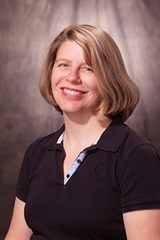This narrative was written by Britt Murphy. Britt served as the ACWHE President in 2006 and currently serves as the Historian.

The Arkansas Council for Women in Higher Education was founded in 1979 to function as a support group for Arkansas women in higher education. No doubt it was the feminist movement that spurred ACWHE’s founding as more women entered the workforce, including higher education.
In those early days, ACWHE was composed of three faculty or staff members from every public and private institution of higher education in the state. In 1991 the bylaws were revised and the membership became open to all administrators, faculty, and staff members who are involved with higher education. Institutions were encouraged to appoint as many representatives as possible, with the minimum being three.
ACWHE’s mission has remained largely unchanged since the late 70s:
- to function as a networking group for Arkansas women in higher education.
- to promote positive institutional change for women in higher education.
- to promote the examination of higher education policies, regulations, and practices in order to improve the status of women on university and college campuses.
- to accumulate, analyze and disseminate data to indicate the position of women on university and college campuses.
- to be informed and disseminate information to administration, faculty, and staff about relevant legislation pertaining to women.
- to encourage administration, faculty, staff, and students to participate in women’s programs at their institutions.
When I got involved with ACWHE around 2000 I was a new librarian at Hendrix College. I was sent by my administrators to a meeting at the then-new library at Arkansas Tech. It was refreshing to be in a group of women who were diverse across many spectrums – race, age, educational background – I was rejuvenated and made many connections.
As happens, I was slowly sucked into leadership since I was willing to volunteer on planning committees. During the early 2000s, ACWHE was holding two meetings – a smaller meeting in the fall and a larger symposium in the spring. Hendrix hosted the spring meeting in 2002 when the campus was also hosting a Women’s Studies/Gender Studies: Separate but Equal Conference. Oyeronke Oyewumi, the author of The Invention of Women, was the keynote speaker for this event.
Fall meetings were less formal and usually relied on one of us to lead a discussion or small groups. Spring meetings would usually feature a keynote and sometimes have panel discussions. The spring meetings became more elaborate when the (now defunct?) Arkansas Association of Women in Two-Year Colleges (AAWTYC) joined forces with ACWHE, including pre-conference movies (Iron Jawed Angels), musical performances, and magic shows.
For example, by 2005, ACWHE held a pre-conference workshop, had a tour of the (then new) Clinton Library, and on the conference day had a national speaker and trainer Deb Sofield as a keynote, a luncheon presentation by the noted political organizer and human rights activist Brownie Ledbetter, and an afternoon panel on leadership essentials presented by a panel of women leaders in Arkansas. These panels usually included women in state government (including Linda Beene, Director of Higher Education for Arkansas, Circuit Court Judge Marcie Hearnsberger, then State Rep. Joyce Eliott, and then State Rep. Johnnie Roebuck), newspaper editors (Melinda Gassaway – Sentinel-Record), and higher ed administrators – usually females. Some keynote speakers included Washington Post reporter and author Juliet Eilperin, and university professors Aeron Haynie (Mama Ph.D.), Mark Taylor (ASU-Beebe), Diane Gilliland (UALR – also the first Director of Higher Education for AR pre-1992), and Gayle White (SAU).
Dr. Sally Carder, President of National Park Community College, and Dr. Janet Smith, President of Rich Mountain Community College, were two powerhouses when I took on a leadership role around 2006, and at that time, the only female CEOs of higher ed institutions in Arkansas. Both supported ACWHE and AAWTYC mightily, and it was during this time (2005-2009) that ACWHE supported its most robust membership in the 20 years I’ve been involved with ACWHE.
After that time period, women from UALR, UCA, and Pulaski Tech traditionally took part in leadership, planning, and hosting the conferences, especially as AATYC fell away from the picture. The logo for ACWHE changed, but pink was always a dominant color, and sometimes the conference day involved feminine themes such as dress and appearance. Scholarships were always a priority, even spurring one of the out-of-state keynote speakers to donate her fee to a scholarship winner.
The constant through the years for me has been a team of dedicated, smart, and hard-working women who believe community makes a better place for women in higher education, no matter the background or job title of the woman. The space we create is a safe and fertile ground for women to dream, learn, and lead. As our numbers grow in the sphere of higher education, our influence does as well, but I think we all know that the struggle lies before us still – too many women employees have too little pay, too many women have few opportunities to the rich advancement that higher education offers and too many women suffer other personal burdens to make time for another degree or take a chance on advancement. We would do well to continue our work!
